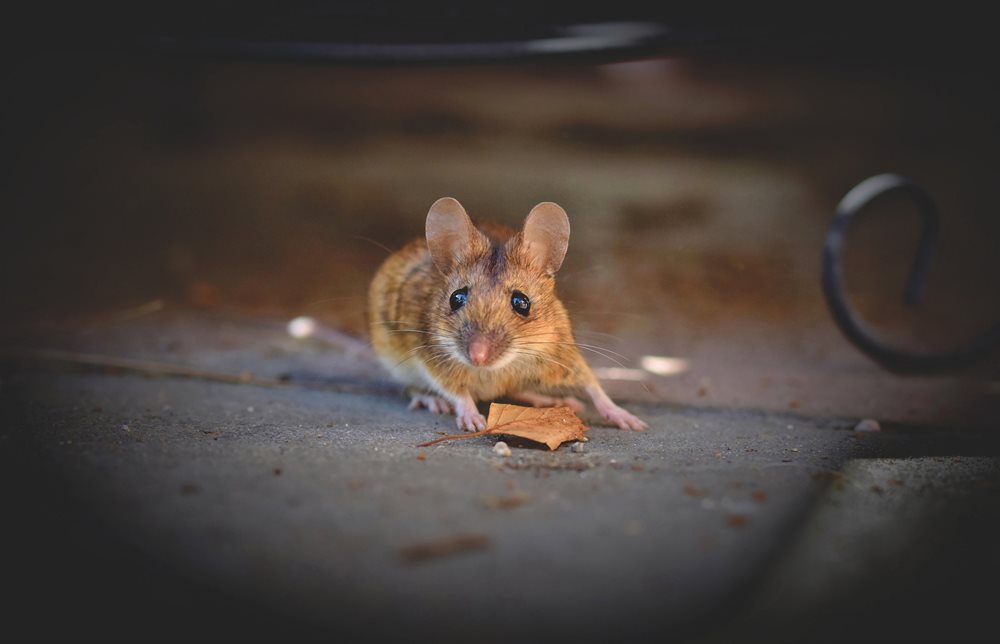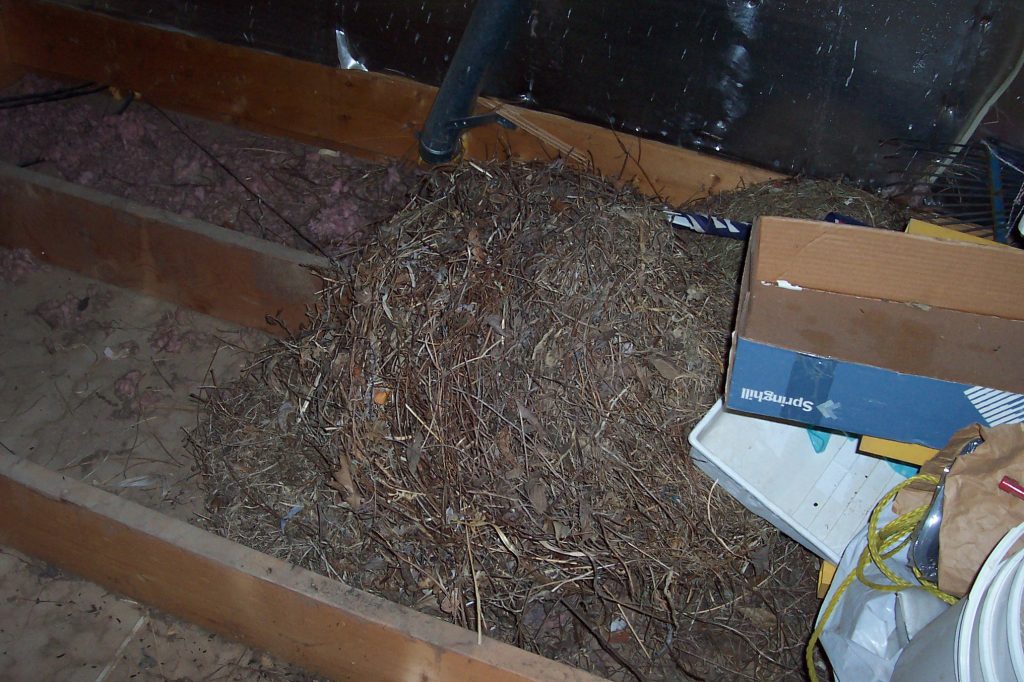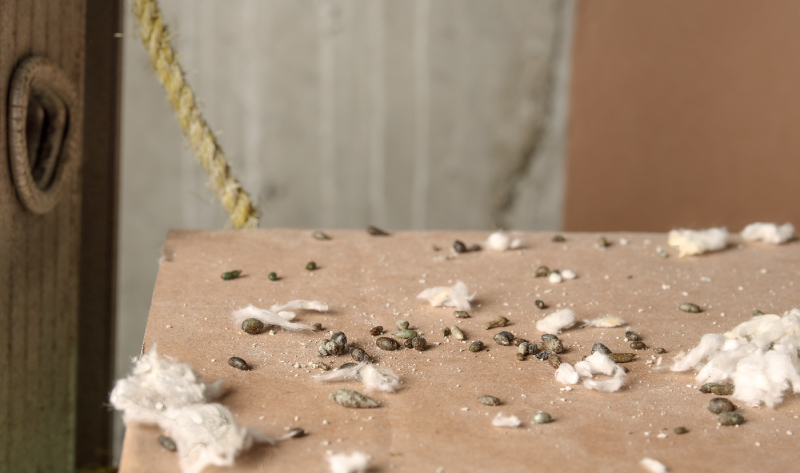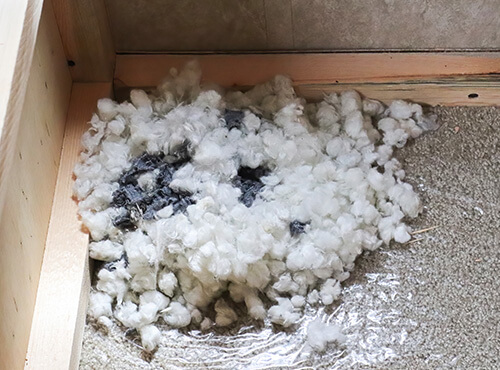
You hear scratching in the walls at night. Maybe you’ve noticed a few crumbs scattered on the counter in the morning, or small droppings near the pantry. These little signs can point to a more pressing issue: mice building nests in house walls, attics, or other hidden spaces.
House mice use a wider variety of materials for their nests, creating a round ball between four and six inches in diameter. Nesting material may include wood chips, pellets, vinyl, plastic, papers, carpet, cardboard boxes, drywall, and insulation. The nest may not be as tightly woven as a rat nest.
Mouse nests may look messy, but the bigger problem is the health risks and damage they cause to homes. They can spread disease, contaminate food, and damage your house’s insulation, wires, and other materials.
What Does a Mouse Nest Look Like?
House mice are crafty builders. They gather shredded materials like paper, cardboard, carpet fibers, insulation, fabric, and even bits of plastic or vinyl. Using these scraps, they shape a round nest about four to six inches across—roughly the size of a grapefruit.

These nests serve as warm shelters where mice raise their young and stash away food. Since, like the hiding mice who built them, they’re often tucked away in quiet corners, most homeowners don’t notice them until the population has already grown.
So, what does a house mouse nest look like? Imagine a messy bundle of torn-up materials tucked out of sight, often with small gnawed crumbs or droppings nearby.
Common Places to Find a Mouse Nest in the House
Mice pick nesting spots that keep them close to food and away from people. The most popular real estate choices in your home fall into a few categories:
- Near food sources: Kitchens, pantries, and cabinets are prime spots for mice because they provide easy access to crumbs, stored food, and even pet dishes. These areas let mice minimize travel time, reducing their exposure while ensuring a steady food supply.
- Hidden spaces: Attics, crawl spaces, and wall voids give mice the perfect cover. These spots are rarely disturbed, making them safe environments to breed, raise pups, and expand their colony without detection.
- Warm areas: Mice find constant warmth behind refrigerators, stoves, and heating units. That steady heat helps them survive colder months and makes these locations ideal for nesting year-round.
- Quiet, sheltered spaces: Garages, closets, and even under vehicle hoods offer mice dark, low-traffic environments where they’re unlikely to be noticed. These sheltered zones provide safety from predators and protection from human activity.
Each location offers safety, warmth, or easy food access; all these are things mice need to thrive indoors. If you’ve spotted signs of mice in the house, don’t wait—there’s a good chance a hidden nest is close by.
Signs of a Mouse Nest in Your Home
Since nests are rarely in plain sight, you’ll often spot the signs of activity before you find the nest. You might notice:
Mouse Droppings and Urine Trails

Gnaw Marks

Gnaw marks on walls, floors, cabinets, and food packaging. Mice constantly chew to keep their teeth from overgrowing, so fresh gnaw marks are a red flag that they’re nearby.
Shredded Materials

- Gnaw marks on walls, floors, cabinets, and food packaging. Mice constantly chew to keep their teeth from overgrowing, so fresh gnaw marks are a red flag that they’re nearby.
- Shredded paper, fabric, or insulation left along baseboards or near furniture. These scraps are often carried back to build or repair a nest.
How to Find a Mouse Nest
If you’ve noticed these signs of mice, there’s likely a nest nearby. Mice rarely travel more than 30 feet from their nests, so they are constructed near food sources. On average, a mouse will leave a nest 40 times a day to find food and water. Also, mice live in colonies; one colony could have one or two dozen mice.
However, this behavior does not make them easier to trap. Also, house mice leave their nests about forty times daily for food and water. Mice live in colonies, and you may have one or two dozen living in the same area.
Why You Shouldn’t Use DIY Removal Methods
When getting rid of a mouse’s nest, your first instinct may be to pick it up, shake it apart, or dump it in the garbage can. Ignore this instinct. Mice carry diseases like Hantavirus and pass them on to humans via direct and indirect means.
You may get bitten if you reach for a nest with a mouse in it. Rodent nests are also filled with feces, urine, and parasites. Touching a nest without protection puts you at risk of encountering mold spores, bacteria, fleas, and ticks, among other unsavory encounters.
So, what should you do if you find a mouse nest? Instead of searching “how to get rid of mice” to find DIY mouse control, call professionals who have the protective gear and experience to handle the mouse problem safely.
How Critter Control Gets Rid of Mice
The fastest way to get rid of mice? Professional help. At Critter Control, we remove the visible problem and address everything that comes with it. Our team follows a proven process designed to protect your home now and in the long run:
- Thorough inspection: Every service begins with a detailed look at your property. We identify not only the nests but also the entry points and hidden areas mice may be using to move around. This gives us a complete picture of the infestation.
- Safe removal: Our specialists handle nests using proper protective equipment and methods that prevent harmful particles, droppings, and parasites from spreading into your living space.
- Sanitization: We clean and disinfect the affected areas once nests are cleared. This step helps remove lingering odors and reduces the risk of bacteria, viruses, or allergens that mice leave behind.
- Long-term prevention: Finally, we put a stop to future infestations. By sealing entry points and applying exclusion techniques, we help ensure mice can’t return.
With inspection, removal, sanitization, and prevention working together, your home stays protected long after the immediate problem is gone. When you have Critter Control on your side, you can feel confident knowing your home is safe, clean, and secure.
Keep Your Home Mouse-Free With Critter Control
Mouse nests threaten both your health and your home’s safety. The good news is, you don’t have to tackle them alone. Our team at Critter Control has the training, tools, and experience to remove nests safely and prevent them from coming back.
If you think there may be a mouse nest in your home, call Critter Control today to schedule an inspection. We’ll help restore your peace of mind—and keep your home mouse-free.
Get them out.
Keep them out.®
Experiencing a wildlife or pest issue? We can help! Complete this form and your local Critter Control® office will contact you to assist.
- Baby Mice
- Dead Mice
- How to Get Rid of Mice
- Mice Behavior in the Winter
- Fear of Mice
- How to Catch a Mouse
- Life Cycle of a Mouse
- Mice in Attic Removal
- Mice in Crawl Space
- Mice in the House
- Mice in the Walls
- Mice in Yard
- Mice Problems
- Mouse Poop & Droppings
- Mice in Pantry
- Mouse Noises
- Mouse Repellent
- Mouse Tracks
- Mouse Traps & Bait
- Mice vs. Rats
- Types of Mice
- Diseases That Mice Carry
- Mouse Appearance
- Where Do Mice Hide?
- White Footed Mouse Habitat